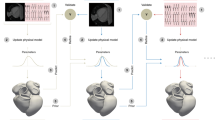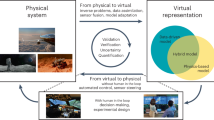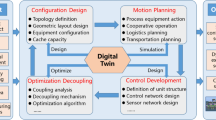Abstract
Digital twins, which are considered an effective approach to realize the fusion between virtual and physical spaces, have attracted a substantial amount of attention in the past decade. With their rapid development in recent years, digital twins have been applied in various fields, particularly in industry. However, there are still some gaps to be filled and some limitations to be addressed. Here we provide a brief overview of digital twin advancements in industry and highlight the main pitfalls to avoid and challenges to overcome, to improve the maturity of digital twins and facilitate large-scale industrial applications in the future.
This is a preview of subscription content, access via your institution
Access options
Access Nature and 54 other Nature Portfolio journals
Get Nature+, our best-value online-access subscription
$29.99 / 30 days
cancel any time
Subscribe to this journal
Receive 12 digital issues and online access to articles
$99.00 per year
only $8.25 per issue
Buy this article
- Purchase on Springer Link
- Instant access to full article PDF
Prices may be subject to local taxes which are calculated during checkout


Similar content being viewed by others
References
Tao, F. & Qi, Q. Make more digital twins. Nature 573, 490–491 (2019).
Lei, Z. et al. Digital twin based monitoring and control for DC–DC converters. Nat. Commun. 14, 5604 (2023).
Ricondo, I., Porto, A. & Ugarte, M. A digital twin framework for the simulation and optimization of production systems. Procedia CIRP 104, 762–767 (2021).
Hernandez-Boussard, T. et al. Digital twins for predictive oncology will be a paradigm shift for precision cancer care. Nat. Med. 27, 2065–2066 (2021).
Coorey, G., Figtree, G. A., Fletcher, D. F. & Redfern, J. The health digital twin: advancing precision cardiovascular medicine. Nat. Rev. Cardiol. 18, 803–804 (2021).
Coorey, G. et al. The health digital twin to tackle cardiovascular disease—a review of an emerging interdisciplinary field. npj Digit. Med. 5, 126 (2022).
Shrivastava, C., Berry, T., Cronje, P., Schudel, S. & Defraeye, T. Digital twins enable the quantification of the trade-offs in maintaining citrus quality and marketability in the refrigerated supply chain. Nat. Food 3, 413–427 (2022).
Schrotter, G. & Hürzeler, C. The digital twin of the city of Zurich for urban planning. J. Photogramm. Remote Sens. Geoinf. Sci. 88, 99–112 (2020).
Aydemir, H., Zengin, U. & Durak, U. The digital twin paradigm for aircraft review and outlook. In AIAA SciTech Forum 0553 (AIAA, 2020).
Coraddu, A. et al. Data-driven ship digital twin for estimating the speed loss caused by the marine fouling. Ocean Eng. 186, 106063 (2019).
Mauro, F. & Kana, A. A. Digital twin for ship life-cycle: a critical systematic review. Ocean Eng. 269, 113479 (2023).
Bauer, P., Stevens, B. & Hazeleger, W. A digital twin of Earth for the green transition. Nat. Clim. Change 11, 80–83 (2021).
Uhlemann, T. H.-J., Lehmann, C. & Steinhilper, R. The digital twin: realizing the cyber-physical production system for Industry 4.0. Procedia CIRP 61, 335–340 (2017).
Wang, K. et al. A review of the technology standards for enabling digital twin. Digit. Twin 2, 4 (2022).
Lo, C. K., Chen, C. H. & Zhong, R. Y. A review of digital twin in product design and development. Adv. Eng. Inform. 48, 101297 (2021).
Pei, F. Q., Tong, Y. F., Yuan, M. H., Ding, K. & Chen, X. H. The digital twin of the quality monitoring and control in the series solar cell production line. J. Manuf. Syst. 59, 127–137 (2021).
Magnanini, M. C. & Tolio, T. A. M. A model-based digital twin to support responsive manufacturing systems. CIRP Ann. 70, 353–356 (2021).
Toothman, M. et al. A digital twin framework for prognostics and health management. Comput. Ind. 150, 103948 (2023).
Michael, G. & Vickers, J. in Transdisciplinary Perspectives on Complex Systems: New Findings and Approaches (eds Kahlen, F. J. et al.) 85–113 (Springer, 2017).
Tao, F. et al. Digital twin-driven product design, manufacturing and service with big data. Int. J. Adv. Manuf. Technol. 94, 3563–3576 (2018).
Negri, E., Berardi, S., Fumagalli, L. & Macchi, M. MES-integrated digital twin frameworks. J. Manuf. Syst. 56, 58–71 (2020).
Negri, E. et al. Field-synchronized digital twin framework for production scheduling with uncertainty. J. Intell. Manuf. 32, 1207–1228 (2021).
Souza, V., Cruz, R., Silva, W., Lins, S. & Lucena, V. A digital twin architecture based on the Industrial Internet of Things technologies. In 2019 IEEE International Conference on Consumer Electronics (ICCE) 1–2 (IEEE, 2019).
Gopal, L. et al. Digital twin and IOT technology for secure manufacturing systems. Meas. Sens. 25, 100661 (2023).
Redelinghuys, A. J. H., Basson, A. H. & Kruger, K. A six-layer architecture for the digital twin: a manufacturing case study implementation. J. Intell. Manuf. 31, 1383–1402 (2020).
Ghosh, A. K., Ullah, A. S., Teti, R. & Kubo, A. Developing sensor signal-based digital twins for intelligent machine tools. J. Ind. Inf. Integr. 24, 100242 (2021).
Cai, Y., Starly, B., Cohen, P. & Lee, Y.-S. Sensor data and information fusion to construct digital-twins virtual machine tools for cyber-physical manufacturing. Procedia Manuf. 10, 1031–1042 (2017).
Shahriar, M. R. et al. MTComm based virtualization and integration of physical machine operations with digital-twins in cyber-physical manufacturing cloud. In 2018 5th IEEE International Conference on Cyber Security and Cloud Computing (CSCloud)/2018 4th IEEE International Conference on Edge Computing and Scalable Cloud (EdgeCom) 46–51 (IEEE, 2018).
Wang, K. J., Lee, Y. H. & Angelica, S. Digital twin design for real-time monitoring—a case study of die cutting machine. Int. J. Prod. Res. 59, 6471–6485 (2021).
Luo, W., Hu, T., Zhang, C. & Wei, Y. Digital twin for CNC machine tool: modeling and using strategy. J. Ambient Intell. Hum. Comput. 10, 1129–1140 (2019).
Urbina Coronado, P. D. et al. Part data integration in the shop floor digital twin: mobile and cloud technologies to enable a manufacturing execution system. J. Manuf. Syst. 48, 25–33 (2018).
Bao, J., Guo, D., Li, J. & Zhang, J. The modelling and operations for the digital twin in the context of manufacturing. Enterp. Inf. Syst. 13, 534–556 (2019).
Koulouris, A., Misailidis, N. & Petrides, D. Applications of process and digital twin models for production simulation and scheduling in the manufacturing of food ingredients and products. Food Bioprod. Process. 126, 317–333 (2021).
Melesse, T. Y., Pasquale, V. D. & Riemma, S. Digital twin models in industrial operations: state-of-the-art and future research directions. IET Collab. Intell. Manuf. 3, 37–47 (2021).
Tao, F., Xiao, B., Qi, Q., Cheng, J. & Ji, P. Digital twin modeling. J. Manuf. Syst. 64, 372–389 (2022).
Rasheed, A., San, O. & Kvamsdal, T. Digital twin: values, challenges and enablers from a modeling perspective. IEEE Access 8, 21980–22012 (2020).
Hürkamp, A. et al. Combining simulation and machine learning as digital twin for the manufacturing of overmolded thermoplastic composites. J. Manuf. Mater. Process 4, 92 (2020).
Tripura, T., Desai, A. S., Adhikari, S. & Chakraborty, S. Probabilistic machine learning based predictive and interpretable digital twin for dynamical systems. Comput. Struct. 281, 107008 (2023).
Balu, A., Sarkar, S., Ganapathysubramanian, B. & Krishnamurthy, A. Physics-aware machine learning surrogates for real-time manufacturing digital twin. Manuf. Lett. 34, 71–74 (2022).
Tabar, R. S., Wärmefjord, K., Söderberg, R. & Lindkvist, L. Efficient spot welding sequence optimization in a geometry assurance digital twin. J. Mech. Des. 142, 102001 (2020).
Namiot, D., Pokusaev, O., Kupriyanovsky, V. & Zhabitskii, M. Digital twins and discrete-event simulation systems. Int. J. Open Inf. Technol. 9, 70–75 (2021).
Morabito, L., Ippolito, M., Pastore, E., Alfieri, A. & Montagna, F. A discrete event simulation based approach for digital twin implementation. IFAC Pap. 54, 414–419 (2021).
Ganguli, R. & Adhikari, S. The digital twin of discrete dynamic systems: initial approaches and future challenges. Appl. Math. Model. 77, 1110–1128 (2020).
Söderberg, R., Wärmefjord, K., Carlson, J. S. & Lindkvist, L. Toward a digital twin for real-time geometry assurance in individualized production. CIRP Ann. 66, 137–140 (2017).
Yan, Q., Wang, H. & Wu, F. Digital twin-enabled dynamic scheduling with preventive maintenance using a double-layer Q-learning algorithm. Comput. Oper. Res. 144, 105823 (2022).
Guo, X., Peng, G. & Meng, Y. A modified Q-learning algorithm for t path planning in a digital twin assembly system. Int. J. Adv. Manuf. Technol. 119, 3951–3961 (2022).
Chen, R., Shen, H. & Lai, Y. A metaheuristic optimization algorithm for energy efficiency in digital twins. Internet Things Cyber Phys. Syst. 2, 159–169 (2022).
Bazaz, S. M., Lohtander, M. & Varis, J. The prediction method of tool life on small lot turning process—development of digital twin for production. Procedia Manuf. 51, 288–295 (2020).
Zhang, H., Qi, Q., Ji, W. & Tao, F. An update method for digital twin multi-dimension models. Robot Comput. Integr. Manuf. 80, 102481 (2023).
Eckhart, M. & Ekelhart, A. A specification-based state replication approach for digital twins. In Proc. 2018 Workshop on Cyber-Physical Systems Security and Privacy 36–47 (Association for Computing Machinery, 2018).
Akbarian, F., Fitzgerald, E. & Kihl, M. Synchronization in digital twins for industrial control systems. Preprint at https://arxiv.org/abs/2006.03447 (2020).
Seok, M. G., Tan, W. J., Cai, W. & Park, D. Digital-twin consistency checking based on observed timed events with unobservable transitions in smart manufacturing. IEEE Trans. Ind. Inform. 19, 6208–6219 (2023).
Talkhestani, B. A., Jazdi, N., Schloegl, W. & Weyrich, M. Consistency check to synchronize the digital twin of manufacturing automation based on anchor points. Procedia CIRP 72, 159–164 (2018).
Huang, S., Wang, G., Lei, D. & Yan, Y. Toward digital validation for rapid product development based on digital twin: a framework. Int. J. Adv. Manuf. Technol. 119, 2509–2523 (2022).
Qamsane, Y. et al. A unified digital twin framework for real-time monitoring and evaluation of smart manufacturing systems. In 2019 IEEE 15th International Conference on Automation Science and Engineering (CASE) 1394–1401 (IEEE, 2019).
Agostino, Í. R. S., Broda, E., Frazzon, E. M. & Freitag, M. in Scheduling in Industry 4.0 and Cloud Manufacturing (eds Sokolov, B. et al.) 39–60 (Springer, 2020); https://doi.org/10.1007/978-3-030-43177-8_3
Aheleroff, S., Xu, X., Zhong, R. Y. & Lu, Y. Digital twin as a service (DTaaS) in Industry 4.0: an architecture reference model. Adv. Eng. Inform. 47, 101225 (2021).
Fang, Y. et al. Digital-twin-based job shop scheduling toward smart manufacturing. IEEE Trans. Ind. Inform. 15, 6425–6435 (2019).
Liu, D., Du, Y., Chai, W., Lu, C. & Cong, M. Digital twin and data-driven quality prediction of complex die-casting manufacturing. IEEE Trans. Ind. Inform. 18, 8119–8128 (2022).
Aivaliotis, P., Georgoulias, K. & Chryssolouris, G. The use of digital twin for predictive maintenance in manufacturing. Int. J. Comput. Integr. Manuf. 32, 1067–1080 (2019).
Errandonea, I., Beltrán, S. & Arrizabalaga, S. Digital twin for maintenance: a literature review. Comput. Ind. 123, 103316 (2020).
van Dinter, R., Tekinerdogan, B. & Catal, C. Predictive maintenance using digital twins: a systematic literature review. Inf. Softw. Technol. 151, 107008 (2022).
Ribeiro da Silva, E., Assad Neto, A. & Nielsen, C. P. in The Future of Smart Production for SMEs: A Methodological and Practical Approach Towards Digitalization in SMEs (eds Madsen, O. et al.) 343–348 (Springer, 2023).
Wanasinghe, T. R. et al. Digital twin for the oil and gas industry: overview, research trends, opportunities, and challenges. IEEE Access 8, 104175–104197 (2020).
Faraway, J. J. & Augustin, N. H. When small data beats big data. Stat. Probab. Lett. 136, 142–145 (2018).
Yu, J., Song, Y., Tang, D. & Dai, J. A digital twin approach based on nonparametric Bayesian network for complex system health monitoring. J. Manuf. Syst. 58, 293–304 (2021).
Dang, S. et al. What should 6G be? Nat. Electron. 3, 20–29 (2020).
Saad, W., Bennis, M. & Chen, M. A vision of 6G wireless systems: applications, trends, technologies, and open research problems. IEEE Netw. 34, 134–142 (2020).
Priyanka, E. B., Thangavel, S., Gao, X.-Z. & Sivakumar, N. S. Digital twin for oil pipeline risk estimation using prognostic and machine learning techniques. J. Ind. Inf. Integr. 26, 100272 (2022).
Chen, Z., Zou, J. & Wang, W. Digital twin-oriented collaborative optimization of fuzzy flexible job shop scheduling under multiple uncertainties. Sādhanā 48, 78 (2023).
Singh, R. & Gill, S. S. Edge AI: a survey. Internet Things Cyber Phys. Syst. 3, 71–92 (2023).
Olortegui-Yume, J. A. & Kwon, P. Y. Tool wear mechanisms in machining. Int. J. Mach. Mach. Mater. 2, 316–334 (2007).
Suo, S. et al. Encryption technology in information system security. In 3rd International Conference on Mechatronics Engineering and Information Technology (ICMEIT 2019) 495–499 (Springer, 2019).
Darabseh, A. et al. SDStorage: a software defined storage experimental framework. In 2015 IEEE International Conference on Cloud Engineering 341–346 (IEEE, 2015).
Gu, M., Li, X. & Cao, Y. Optical storage arrays: a perspective for future big data storage. Light. Sci. Appl. 3, e177 (2014).
Lv, Z. & Xie, S. Artificial intelligence in the digital twins: state of the art, challenges, and future research topics. Digit. Twin 1, 12 (2022).
Carabantes, M. Black-box artificial intelligence: an epistemological and critical analysis. AI Soc. 35, 309–317 (2020).
Blazek, P. J. & Lin, M. M. Explainable neural networks that simulate reasoning. Nat. Comput. Sci. 1, 607–618 (2021).
Lundberg, S. M. et al. From local explanations to global understanding with explainable AI for trees. Nat. Mach. Intell. 2, 56–67 (2020).
Gunning, D. et al. XAI—explainable artificial intelligence. Sci. Robot. 4, eaay7120 (2019).
Khan, A., Shahid, F., Maple, C., Ahmad, A. & Jeon, G. Toward smart manufacturing using spiral digital twin framework and twinchain. IEEE Trans. Ind. Inform. 18, 1359–1366 (2022).
Suhail, S. et al. Blockchain-based digital twins: research trends, issues, and future challenges. ACM Comput. Surv. 54, 240:1–240:34 (2022).
Yaqoob, I. et al. Blockchain for digital twins: recent advances and future research challenges. IEEE Netw. 34, 290–298 (2020).
Tao, F. et al. makeTwin: a reference architecture for digital twin software platform. Chin. J. Aeronaut. https://doi.org/10.1016/j.cja.2023.05.002 (2023).
Niederer, S. A. et al. Scaling digital twins from the artisanal to the industrial. Nat. Comput. Sci. 1, 313–320 (2021).
Suhail, S., Jurdak, R. & Hussain, R. Security attacks and solutions for digital twins. Preprint at https://doi.org/10.48550/arXiv.2202.12501 (2023).
Acknowledgements
This work is financially supported by the National Natural Science Foundation of China (NSFC) under grants 52120105008 and 52275471, the National Key Research and Development Program of China under grant 2020YFB1708400, and the New Cornerstone Science Foundation through the XPLORER PRIZE.
Author information
Authors and Affiliations
Contributions
All authors contributed to the writing and editing of this paper.
Corresponding author
Ethics declarations
Competing interests
The authors declare no competing interests.
Peer review
Peer review information
Nature Computational Science thanks Michael Grieves, George Q. Huang and Jay Lee for their contribution to the peer review of this work. Primary Handling Editor: Fernando Chirigati, in collaboration with the Nature Computational Science team.
Additional information
Publisher’s note Springer Nature remains neutral with regard to jurisdictional claims in published maps and institutional affiliations.
Rights and permissions
Springer Nature or its licensor (e.g. a society or other partner) holds exclusive rights to this article under a publishing agreement with the author(s) or other rightsholder(s); author self-archiving of the accepted manuscript version of this article is solely governed by the terms of such publishing agreement and applicable law.
About this article
Cite this article
Tao, F., Zhang, H. & Zhang, C. Advancements and challenges of digital twins in industry. Nat Comput Sci 4, 169–177 (2024). https://doi.org/10.1038/s43588-024-00603-w
Received:
Accepted:
Published:
Issue Date:
DOI: https://doi.org/10.1038/s43588-024-00603-w
This article is cited by
-
Digital twins in mechanical and aerospace engineering
Nature Computational Science (2024)



